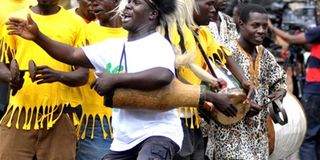Unesco lists western Kenya dance Isikuti as endangered cultural heritage

Dancers perform the Isukuti dance during the Labour Day celebrations on May 1, 2014. FILE PHOTO | NATION MEDIA GROUP
What you need to know:
- Composers in the Isukha and Idakho communities “prefer to work in more commercial genres.
- A male child-cleansing ceremony of the Lango people of Uganda and the oral tradition of Venezuela's Mapoyo group were listed along with the Isukuti dance.
NEW YORK
A traditional dance practised by the Isukha and Idakho communities in western Kenya was listed on Wednesday by a United Nations agency as an “intangible cultural heritage in urgent need of safeguarding.”
The fast-paced Isukuti dance, performed at many public and private celebrations, is among three traditions that the UN Educational, Scientific and Cultural Organisation (Unesco) declared in danger of fading into extinction.
A male child-cleansing ceremony of the Lango people of Uganda and the oral tradition of Venezuela's Mapoyo group were listed along with the Isukuti dance.
“Transmission of Isukuti dance is presently weakening and the frequency of performance is diminishing,” warns a Unesco committee that seeks to protect threatened aspects of humanity's cultural heritage.
“Many bearers are elderly and lack successors to whom they can pass on their knowledge. Lack of funds and the necessary materials to make the instruments and costumes also present an obstacle.”
Composers in the Isukha and Idakho communities “prefer to work in more commercial genres,” the Unesco committee notes, adding that local audiences “frequently substitute contemporary entertainment for traditional Isukuti dances.”
FESTIVALS
Unesco describes Isukuti dance as “an integral tool for cultural transmission and harmonious coexistence between families and communities.”
It is passed down through generations of a family and is performed at most stages of life, including childbirths, initiations, weddings, funerals and commemorations, as well as at religious festivals and sporting events.
The dance derives its name from the set of drums that accompany it. An antelope horn and metal rattles are also played as a soloist sings in tandem with the rhythms of the drumbeats and the steps of the dancers, arranged in separate rows for women and men.
Pressures threatening perpetuation of the dance include indifference to it on the part of “young people who identify less and less with Isukuti,” Unesco observes.




